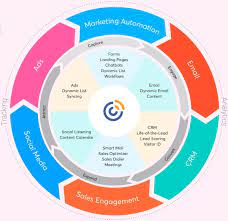Marketing Automation: Streamlining Your Strategy for Success
In today’s fast-paced digital landscape, businesses are constantly seeking ways to enhance their marketing efforts and drive better results. One powerful tool that has revolutionised the way companies engage with their audience is marketing automation.
Marketing automation involves using software and technology to automate repetitive marketing tasks such as email campaigns, social media posting, lead nurturing, and more. By streamlining these processes, businesses can save time, improve efficiency, and deliver more personalised and targeted messages to their customers.
One of the key benefits of marketing automation is its ability to nurture leads throughout the buyer’s journey. By tracking customer interactions and behaviour, businesses can deliver the right message at the right time, ultimately increasing conversion rates and driving revenue.
Moreover, marketing automation allows businesses to create more consistent and cohesive marketing campaigns across multiple channels. Whether it’s sending automated follow-up emails after a website visit or scheduling social media posts to reach a wider audience, automation helps maintain brand consistency and engagement.
Another advantage of marketing automation is its ability to provide valuable insights and analytics. By tracking campaign performance metrics such as open rates, click-through rates, and conversion rates, businesses can measure the effectiveness of their marketing efforts and make data-driven decisions for future strategies.
Overall, marketing automation has become an essential tool for modern businesses looking to stay competitive in today’s digital age. By automating repetitive tasks, nurturing leads effectively, maintaining brand consistency, and analysing campaign performance, businesses can streamline their marketing efforts and achieve greater success in reaching their target audience.
Top 7 Essential Tips for Effective Marketing Automation
- Segment your audience for targeted messaging
- Personalize your communication to increase engagement
- Automate repetitive tasks to save time and resources
- Use data analytics to track and improve campaign performance
- Integrate marketing automation with CRM for a seamless customer experience
- Test different strategies to optimize conversion rates
- Stay updated with industry trends and best practices
Segment your audience for targeted messaging
Segmenting your audience for targeted messaging is a crucial tip in marketing automation. By dividing your audience into specific groups based on demographics, behaviour, or preferences, you can tailor your messages to resonate with each segment effectively. This approach not only increases the relevance of your communications but also enhances engagement and conversion rates. By delivering personalised content that addresses the unique needs and interests of different audience segments, you can build stronger relationships with your customers and ultimately drive better results for your business.
Personalize your communication to increase engagement
Personalising your communication is a crucial tip in marketing automation to enhance customer engagement. By tailoring your messages to individual preferences, behaviours, and demographics, you can create a more meaningful connection with your audience. Personalisation shows customers that you understand their needs and interests, increasing the likelihood of them engaging with your content and taking desired actions. Whether it’s addressing customers by their name in emails, recommending products based on their past purchases, or sending targeted offers, personalised communication can significantly improve the effectiveness of your marketing campaigns and ultimately drive better results.
Automate repetitive tasks to save time and resources
Automating repetitive tasks is a key strategy in marketing automation that can significantly benefit businesses by saving valuable time and resources. By leveraging automation tools to handle routine marketing activities such as email campaigns, social media scheduling, and lead nurturing processes, companies can free up their teams to focus on more strategic initiatives. This not only increases efficiency but also allows employees to dedicate their time and skills to more creative and high-impact tasks, ultimately leading to improved productivity and better results for the business.
Use data analytics to track and improve campaign performance
Utilising data analytics to track and enhance campaign performance is a crucial aspect of effective marketing automation. By leveraging insights from metrics such as open rates, click-through rates, and conversion rates, businesses can gain valuable information on the effectiveness of their campaigns. Analysing this data allows for informed decision-making, enabling companies to identify areas for improvement, refine targeting strategies, and ultimately achieve better results in engaging with their audience.
Integrate marketing automation with CRM for a seamless customer experience
Integrating marketing automation with Customer Relationship Management (CRM) systems is a crucial strategy for creating a seamless customer experience. By syncing these two powerful tools, businesses can track customer interactions, preferences, and behaviours in one centralised platform. This integration enables businesses to deliver personalised and timely marketing messages based on customer data stored in the CRM system, ultimately enhancing customer engagement and satisfaction. Additionally, aligning marketing automation with CRM allows for better lead nurturing, improved sales processes, and more effective communication strategies, leading to a cohesive and streamlined customer journey across all touchpoints.
Test different strategies to optimize conversion rates
Testing different strategies is a crucial aspect of optimising conversion rates through marketing automation. By experimenting with various approaches, such as email content, timing of campaigns, or call-to-action placements, businesses can gather valuable insights into what resonates best with their audience. Through A/B testing and data analysis, companies can identify the most effective tactics to drive conversions and tailor their marketing efforts accordingly. This iterative process of testing and refining strategies enables businesses to continuously improve their conversion rates and maximise the impact of their marketing automation initiatives.
Stay updated with industry trends and best practices
Staying updated with industry trends and best practices is crucial when implementing marketing automation strategies. By keeping abreast of the latest developments in the field, businesses can ensure that their automation efforts remain relevant and effective. Industry trends can provide valuable insights into new technologies, consumer preferences, and emerging marketing strategies, helping businesses adapt their automation processes to meet changing demands. Similarly, staying informed about best practices in marketing automation allows businesses to learn from successful strategies and avoid common pitfalls, ultimately maximising the impact of their automated campaigns and driving better results.
